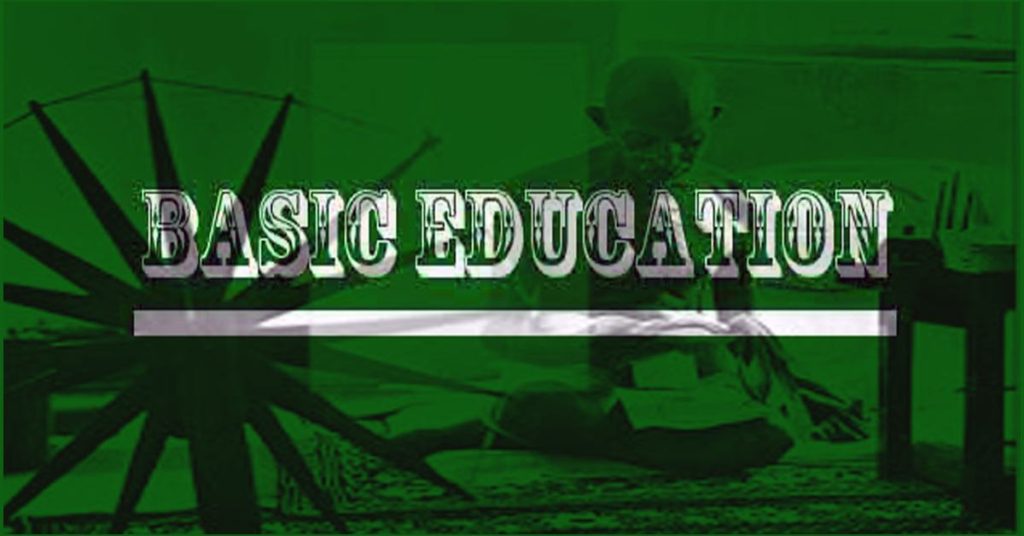“By education, I mean an all-round drawing out of the best in child and man body, mind, and spirit.”- Mohandas Karamchand Gandhi
Basic Education: The Wardha Scheme of Education.
The term ‘Basic’ is significant in Basic Education. Basic comes from the term “Base”. Which means bottom or foundation. So in the literary sense, Basic education (Wardha scheme of Education) is the foundation of education or education at the primary level on which the edifice of the Superstructure of Higher Education can be built.
It is called basic education because :
- it is grounded in the cultural traditions of India
- it emphasizes the acquisition of certain minimum knowledge and skills that every child is required to possess irrespective of caste Creed color and gender
- it is the primary or starting point of Once education
- it is designed to meet the needs of the common man of the country
- it tries to utilize the inherent abilities of the child to the fullest extent
- it is correlated with the basic requirements like food, dress, shelter healthful living, etc
- it is closely related to the basic occupation of the society
Origin of Basic Education (Nai Talim)
The most significant contribution of Gandhiji to education was the basic scheme. His long experience and experiments in the field of education helped him to devise a new scheme of education suitable for his native country India. Buy a Book
When Gandhiji was in South Africa, he used to teach his children with other students and illiterate on the Tolstoy farm of the transversal. Manual work was given top priority by him while educating the children.
It was a novel attempt and he was successful in his experiment.
Sabarmati Ashram

After returning to India in 1919 he set up Sabarmati Ashram. In the Ashram, there was a school for children and illiterates. Emphasis on manual work with Charakha and Khadi.
In 1935, Gandhiji shifted to Sevagram Ashram, 11 kilometers away from Wardha. There he published a journal called ‘The Harijan’. by name where he Expresses his educational ideas and practices.
In 1937, Gandhiji chalked out a detailed plan for his New education. The scheme was Called basic education. which was hailed all over the country. Doctor Zakir Hussain prepared the detailed scheme of the basic education curriculum.
After independence, the Wardha scheme was accepted in India as the National system of education. By Basic Education, Gandhiji suggested a scheme of education for the children of the age group 7 to 14. Later he recommended a comprehensive scheme of education as stated below.
Basic Education Scheme pattern
- Pre-basic (up to 6 years )
- Basic (from 7 to 14 years)
- Post-Basic (from 15 to 18)
- University education
- social and adult education
Features of Basic Education/Wardha Scheme
1. free and compulsory education for all
- Buniyadi Shikshya emphasizes free and compulsory education at least for seven years.
- It implies that parents will not pay any fees for the education of the children and for which they must send their children to school.
- It is the most important future of basic education.
2. Seven years of education for all children
- Basic education emphasizes free and compulsory education for seven years. i.e. for completion of primary education.
- It is a must for enabling children to acquire a minimum level of achievement in order to lead a self-reliant and civilized life.
3. Purposeful education
- Any type of education will be meaningless unless it is goal-oriented and purposeful keeping the above idea in view, basic education centers around certain purposeful activities.
4. Education for the mass
- The Wardha scheme of education does not matter in the interest of any one class for the group.
- It lays emphasis on education for the whole population of the country irrespective of caste, creed, color, sex, or economic status.
- At the time, the British system of education was a privilege of the privileged class, in other words, it was meant for a class but not for The Mass.
- However basic education was designed for one and all.
5. Education for the whole country
- The Wardha scheme of education was revised considering the socio-economic and educational conditions of the people of India .
- It is prepared in such a way that to meet the needs and demands of teeming millions of India the scheme was prepared in such a manner as to provide education to all children at a reasonable cost.
6. Mother tongue as the medium of instruction
- Instead of English Gandhiji argued to make the mother tongue the medium of instruction in educational institutions.
- Through the mother tongue, the child can develop his power of understanding expression, reasoning, and thinking.
- Through the mother tongue, the child can also develop his creative power and literary so the Wardha scheme of Education emphasizes to impact of education on children through the medium of the mother tongue.
7. Craft-centered education
- Craft-centered education implies that craft should be the starting point of all other subjects.
- Stress was laid on the principle of “cooperative activity, planning, accuracy, initiative, and individual responsibility In learning.”
- The craft was the center of the whole teaching-learning process.
- Anyway, crops and education should not be misunderstood as education plus craft rather it is education through Craft.
- In other words, crops like spinning, weaving, and Agriculture were made the center of all educational activities in the Wardha scheme of education.
8. Self-supporting education
- Wardha Scheme was based on the principle of self-sufficiency or self-supporting.
- It implies that the production made by craftwork like spinning and weaving could meet the teacher’s cost in education, as a result, the Wardha Scheme could minimize the economic burden on the government.
9. Child-centered education
- Wardha scheme is meant for child-centered.
- The child is the benefit of the center’s entire gamut of educational activities the whole of the curriculum comprises the Real Experience gained by the child through work and play all running is correlated with the activities of the child.
10. Correlated teaching
- Gandhiji wanted to employ basic craft as the medium of teaching all knowledge should be correlated with craft.
- Later on, Dr. Zakir Hussain’s committee added more centers of correlation namely social environment and physical environment.
- All educational activities should, therefore, be integrated and correlated with the craft’s social environment and physical environment.
11. Education for all-round development
- Education should aim at the development of an integrated and balanced responsibility for the child.
- All-around development of the personality of a child is aimed at Wardha Scheme.
- The Wardha scheme of education was designed to develop intellectual physical social-emotional moral and ethical aspects of a child’s personality.
To read the topic “importance of idealism in education,” please Click here


